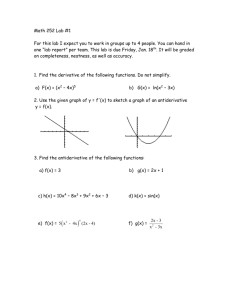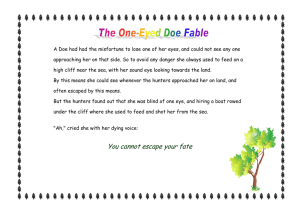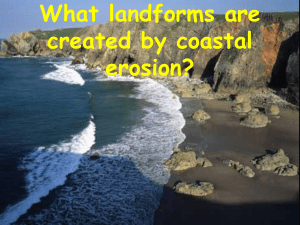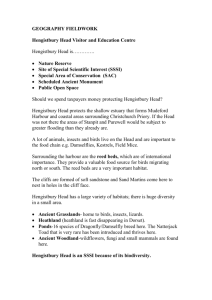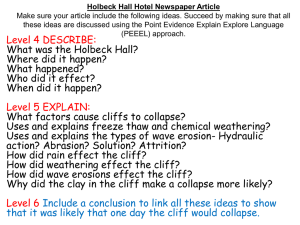erosional landforms
advertisement
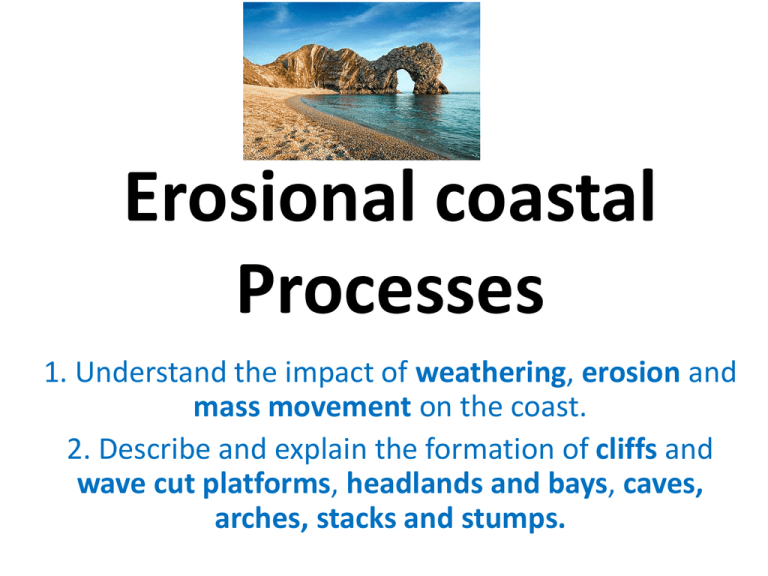
Erosional coastal Processes 1. Understand the impact of weathering, erosion and mass movement on the coast. 2. Describe and explain the formation of cliffs and wave cut platforms, headlands and bays, caves, arches, stacks and stumps. What is the difference between weathering and erosion? Weathering is the wearing away of rocks. Erosion is when material is worn away and removed. 1. Biological weathering Caused by the action of plants on rocks. 2. Physical/ Mechanical weathering Caused by changes the weather e.g. temperature. Freeze thaw weathering is where water gets into cracks in the rock, when the temp falls below freezing the water expands as it turns to ice, this puts pressure on the rock and bits can be caused to break off. 3. Chemical weathering Caused by the action of water on chemicals in the rock. Erosion Erosion is the movement of particles by wind, water, ice or people. Coastal Processes There are 3 main things that coasts can do: 1. They erode material 2. Then they transport material 3. And finally they deposit material What are the processes of erosion along a coastline? The same 4 processes of erosion that are at work on rivers also apply to coasts. • Hydraulic action: The force of the water causes cracks in the cliffs and material gradually breaks off. • Abrasion/corrasion: Bits of rock and sand in waves grind down cliff surfaces like sandpaper. • Attrition: Waves smash rocks and pebbles on the shore into each other, and they break and become smoother. • Corrosion/Solution: Acids contained in sea water will dissolve some types of rock such as chalk or limestone. WHY do we need to know this? Coastal Erosion • http://www.youtube.com/watch?v=zUh3Weil FN4 Mass movement: cliff slumping One of the most common features of a coastline is a cliff. Cliffs are shaped through a combination of erosion and weathering - the breakdown of rocks caused by weather conditions. Soft cliff material leads to cliff slumping Soft Cliff Material • Cliffs formed from soft material (e.g. boulder clay) are more prone to erosion. • The soft boulder clay is quickly eroded away at the base by hydraulic action and corrosion. • However this is not the only way it is being worn away, rainfall also causes weathering. This often happens where layers of boulder clay become saturated and cause the cliff to slump. • The debris on the beach is then eroded by the sea leaving the cliff exposed once more. Stage1 - the soft boulder clay holds rainwater Stage2 - Waves erode the base of the cliff creating a wave cut notch. The clay becomes saturated and forms a slip plane (slip plane: the area where water saturated rock slips a cliff under the force of gravity) Stage 3 - The weight of the saturated cliff causes it to slump. Mark scheme Wave cut platform http://www.youtube.com/watch?v=z 1swjSvgx6A Cliffs, wave cut platforms and wave cut notches Cliffs, wave cut platforms and wave cut notches FORMATION Organise these statements and label them on the diagram 1. The backwash carries the rubble towards the sea forming a wave-cut platform. 2. The process repeats and the cliff continues to retreat. 3. The sea attacks the base of the cliff forming a wavecut notch. 4. The notch increases in size causing the cliff to collapse. 5. Weather weakens the top of the cliff. Peer assessment More resistant rock In areas where there is more resistant/hard rock cliff collapse occurs. In areas of more resistant cliff material erosion is greatest when waves break at the foot of a cliff. This causes erosion at the base of the cliff. This creates a wave-cut notch in the base of the cliff. As the notch increases in size the weight of the cliffs above become too much and the cliff collapses. The material from the cliff is broken up through attrition and some of then remains at the base of the cliff forming a terrace known as a wave cut platform. Concordant and discordant coastlines • Coastlines where the geology alternates between strata (or bands) of hard rock and soft rock are called discordant coastlines. A concordant coastline has the same type of rock along its length. Concordant coastlines tend to have fewer bays and headlands. Discordant Concordant Headlands and bays Headlands and Bays • These form where there are alternating layers of hard and soft rock along a coastline. • Where there is more resistant rock it will be worn away more slowly leaving a headland sticking out to sea. • Softer rock will be eroded more quickly forming a bay. Headlands and Bays • http://www.youtube.com/watch?v=c5gpkGIu B2M Caves, arches, stacks and stumps • http://www.youtube.com/watch?v=UWIO90H xhEQ Caves, arches, stacks and stumps Caves, arches, stacks and stumps These are landforms of erosion along a coastline. • Even hard rock, that forms headlands, contains weaknesses. Hydraulic action forms cracks in the rock until an opening is formed. • As the waves continue to attack the rock is hollowed out to form a cave. • Further erosion means that the cave is widened and deepened until it becomes an arch. • Widening of the arch through undercutting means that material becomes unsupported and collapses into the sea forming a stack. • Further undercutting causes the stack to collapse leaving only a stump. Draw a diagram/series of diagrams and annotate them to show the processes Markscheme Peer assessment
